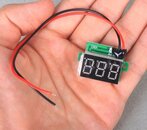yojreilly
Guest
Hi
I just bought a Tekna DV-3X
I'm going to clean it up and install new o rings
I'm thinking about 4 Li-ion 18650 from all battery .com
each battery of the four battery's are 3.7 volt X 4 = 14.8 volts
each battery is 9.62 watt hours X4 = 38.48 watt hours
The old battery's were 12 v each and 17.5 amp hours each = 24 volt 35 amp hour
I'm not sure what I'm doing with the watt hours and amp hours
Also I have not heard back from All battery as to the size of the 18650 as to if it will fit in my battery compartment.
Has anyone installed these battery's in there Tekna ?
Or is there a better way to repower the Tekna
Thanks for any help
I just bought a Tekna DV-3X
I'm going to clean it up and install new o rings
I'm thinking about 4 Li-ion 18650 from all battery .com
each battery of the four battery's are 3.7 volt X 4 = 14.8 volts
each battery is 9.62 watt hours X4 = 38.48 watt hours
The old battery's were 12 v each and 17.5 amp hours each = 24 volt 35 amp hour
I'm not sure what I'm doing with the watt hours and amp hours
Also I have not heard back from All battery as to the size of the 18650 as to if it will fit in my battery compartment.
Has anyone installed these battery's in there Tekna ?
Or is there a better way to repower the Tekna
Thanks for any help





